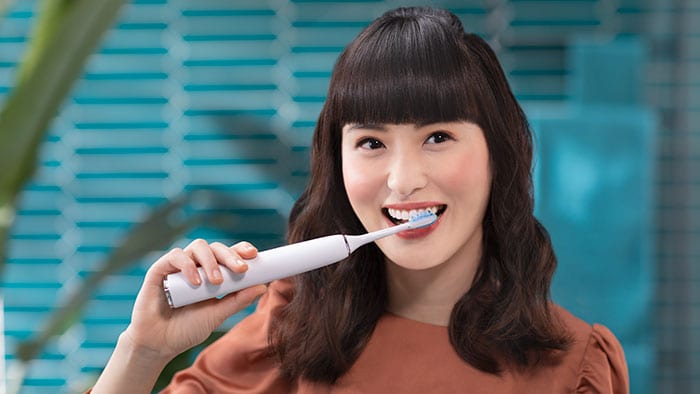An Assessment of Gingivitis Reduction and Plaque Removal by Philips Sonicare DiamondClean with Premium Plaque Control Brush Head and Oral-B 7000 with CrossAction Brush Head
Starke M, Delaurenti M, Ward M, Souza S, Milleman KR, Milleman JL. J Clin Dent 2017;28(Spec Iss A):A29-35.

Objective
To compare the effects of Philips Sonicare DiamondClean with Premium plaque control* brush head and Oral-B 7000® with CrossAction™ brush head and SmartGuide accessory on gingival inflammation, gingival bleeding and surface plaque following two and six weeks of home use.
Methodology
Two hundred eighty-four adults (mean age 38.6 years, 213 female/71 male) were consented, enrolled and completed this randomized, parallel-design study. Eligible subjects were routine manual toothbrush users who were non-smokers, aged 18-65 with a minimum plaque score of ≥1.8 per Lobene and Soparker Modified Plaque Index (MPI) following 3-6 hours of plaque accumulation, and a Gingival Bleeding Index (GBI) of ≥1 on at least 50 sites. Eligible subjects were randomly allocated to utilize either a Philips Sonicare DiamondClean with Premium plaque control brush head or an Oral-B 7000 with CrossAction brush head and SmartGuide accessory. Both products were used in their respective Deep Clean modes, and all subjects received a standard fluoride- containing dentifrice for home use. The use of any other oral hygiene products were prohibited for the study period. Gingivitis (Modified Gingival Index (MGI)), GBI and MPI efficacy metrics were assessed at Baseline, and following two and six weeks of home use. Subjects presented to clinic for all visits with 3-6 hours of plaque accumulation. Safety was assessed by intraoral exam and per subject report.
Results
Gingival Inflammation per Modified Gingival Index (MGI) At Baseline, the MGI values between treatment groups were balanced, p-value = 0.7174. Following two weeks of product use, LS Mean (SE) for the Sonicare group was 1.46 (0.04), and for the Oral-B group it was 1.89 (0.04), p-value <0.0001. Expressed as percent reduction versus Baseline, this is 44.73% reduction for Sonicare and 27.92% for Oral-B. Following six weeks of product use, LS Mean (SE) for the Sonicare group was 1.43 (0.04), and for Oral-B it was 1.91 (0.04), p-value <0.0001. Expressed as percent reduction versus Baseline, this is 45.68% reduction for Sonicare, and 26.83% for Oral-B. Gingival Bleeding per Gingival Bleeding Index (GBI) At Baseline, the GBI values between treatment groups were balanced, p-value = 0.5986. Following two weeks of product use, LS Mean (SE) for the Sonicare group was 0.18 (0.01), and for Oral-B 7000 it was 0.27 (0.01), p-value <0.0001. Expressed as percent reduction versus Baseline, this is 66.75% reduction for Sonicare and 49.38% for Oral-B. Following six weeks of product use, LS Mean (SE) for the Sonicare group was 0.13 (0.01), and for Oral-B it was 0.22 (0.01) , p-value <0.0001. Expressed as percent reduction versus Baseline, this is 75.81% reduction for Sonicare, and 58.76% for Oral-B. At Baseline, the MPI values between treatment groups were balanced, p-value = 0.9777. Following two weeks of product use, LS Mean (SE) for the Sonicare group was 1.78 (0.04), and for Oral-B it was 2.36 (0.04), p-value <0.0001. Expressed as percent reduction versus Baseline, this is 38.68% reduction for Sonicare and 18.28% for Oral-B. Following six weeks of product use, LS Mean (SE) for the Sonicare group was 1.80 (0.04), and for Oral-B it was 2.30 (0.04), p-value <0.0001. Expressed as percent reduction versus Baseline, this is 37.58% reduction for Sonicare, and 20.70% for Oral-B. There were eight adverse events reported, six of which were assessed as mild in severity, two of which were moderate. The disposition of all eight events were indicated as resolved by the end of the study.
Surface Plaque per Modified Plaque Index (MPI)
Safety
Conclusions
Philips Sonicare DiamondClean with Premium plaque control brush head was statistically superior to Oral-B 7000 with CrossAction brush head in reducing gingival inflammation, as measured by MGI, following 14 and 42 days of home use. Philips Sonicare DiamondClean with Premium plaque control brush head was statistically superior to Oral-B 7000 with CrossAction brush head in reducing gingival bleeding, as measured by GBI, following 14 and 42 days of home use. Philips Sonicare DiamondClean with Premium plaque control brush head was statistically superior to Oral-B 7000 with CrossAction brush head in reducing surface plaque, as measured by MPI, following 14 and 42 days of home use. Both products were safe for home use.
*Brush head formerly called AdaptiveClean © 2017 Koninklijke Philips N.V. (KPNV ). All rights reserved. PHILIPS and the Philips shield are trademarks of KPNV. SONICARE and the Sonicare logo are trademarks of KPNV and/or Philips Oral Healthcare, LLC. Data on file - MAH-16-0189

